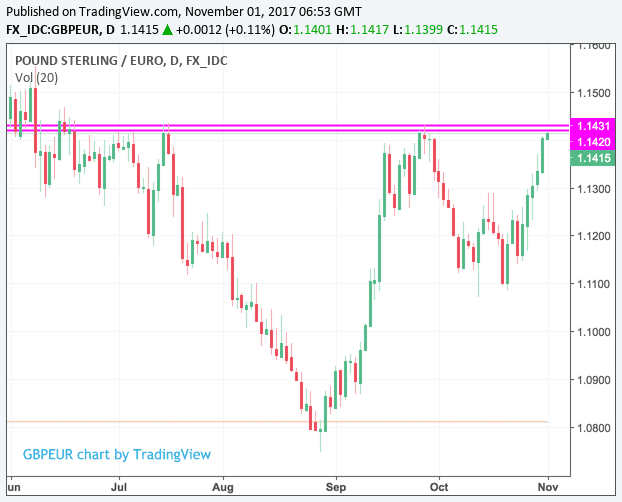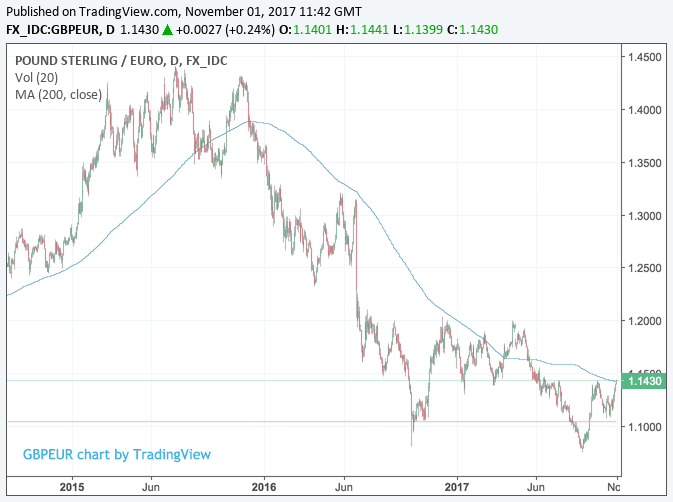British Pound Tests Key Make-or-Break Level vs. Euro
- Written by: James Skinner

The Pound-to-Euro exchange rate could achieve its best level since June over the coming days, according to one strategist, with weakness seen as relatively limited ahead of December’s crunch European Council summit.
Recent price action and a confluence of technical indicators on the GBP/EUR charts suggest the 1.1460 level could form a natural target for the exchange rate in the approach to the Bank of England’s Thursday interest rate announcement.
“EUR/GBP remains on the defensive,” says Karen Jones, a technical analyst at Commerzbank. “The 2015-2017 uptrend at 0.8821 has been eroded and attention has reverted to the major band of support, which extends down to 0.8723/56, the July and September lows, the 200 day and 55 week ma.”
Technical studies are typically conducted on the EUR/GBP pair, but those looking at it from the other angle merely have to flip the numbers and terminology. Translating Jones’ assessment tells us the GBP/EUR is on the offensive with the 2015-2017 downtrend being eroded at 1.1340. She is looking for Sterling to press against a major resistance point in the 1.1440/20 region.
This resistance at 1.1440/20 is absolutely key for many commentators and analysts we follow.
Above: Analysts are basing near-term predictions for Sterling on a key band of resistance in the GBP/EUR charts.
Resistance levels are where we would expect to encounter a great deal of selling as traders place buy and sell orders around these points having seen direction change here in the past. In short, many expect history to repeat and assume others in the market are thinking the same way.
It is a case of self-reinforcement by the market and is why technical studies are so effective at predicting future price action. However, any break of resistance will of course most likely depend on external fundamental drivers.
“With the ECB moving to a more dovish footing, we see scope for EUR/GBP to accelerate lower to test support around 0.8745,” seconds James Rossiter, a strategist at TD Securities, referencing a level that implies a Pound-to-Euro rate of 1.1435. “We see this as a near-term tactical position, however.”
The Pound has gained close to 2.0% over the Euro during the last week after data showed the UK economy regaining a portion of the momentum it lost earlier in the year and expectations for a Bank of England rate hike on Thursday solidified.
A 0.25% interest rise at the Bank of England on Thursday, November 2 is a near-certainty and the question to ask from a currency perspective is whether the interest rate rise is a one-off, or whether one or two more subsequent rate rises will occur in 2018.
If yes, the Pound should rise, if no, the Pound should fall.
Ipek Ozkardeskaya at London Capital Group says the Euro "fell off the cliff" versus the Pound and the sell-off has accelerated after the 200-day moving average (at 1.1372) was cleared.
"Whether the pound would consolidate gains against the single currency will mostly depend on the BoE reaction,” says Ozakardeskaya.
If we look at the following graph we can see the 200 day moving average - i.e. the average price of Sterling-Euro over the past 200 days - and observe Sterling simply fails to sustain a move above here. It is a key level of resistance that has kept the exchange rate in a downward since 2015:
Prior to 2015 - when Sterling was in an uptrend against the Euro - the exchange rate traded above the 200 day average. Therefore, technical analysts are inclined to believe that a sea-change in Sterling's fortunes is to take place should the level be broken and - imporantly - held. (Note the false break earlier in 2017.)
Either way, this is an important level that will determine Sterling's outlook.
Get up to 5% more foreign exchange by using a specialist provider by getting closer to the real market rate and avoid the gaping spreads charged by your bank for international payments. Learn more here.
Brexit Talks
The second trigger to whether Sterling can overcome key technical resistance points lies with the progress of Brexit talks.
The Pound strengthened on October 31 when the EU’s chief Brexit negotiator Michel Barnier said he was willing to look at ways of speeding up Brexit talks. A request for such a move was made by the UK who believe the pace of talks need to speed up and markets bid Sterling in the belief that this is a small step forward in avoiding a cliff-edge no-deal Brexit.
Brexit talks commence again next week, and the outcome could be a further catalyst to moves in Sterling.
The outlook for the Pound-to-Euro rate beyond the current week remains more clouded, with December’s European Council summit a make-or-break moment for the narrative around Sterling.
“We continue to believe that the Brexit negotiations pose risks to the outlook for GBP in the coming months despite the market’s relative complacency on the final outcome,” says Kamal Sharma, a G10 foreign exchange strategist at Bank of America Merrill Lynch.
If agreement cannot be reached in December for negotiations between the UK and the EU to progress onto the subjects of trade and transition, then markets could begin to panic that a deal will not be reached.
“We still expect a rather hard Brexit and thus remain long-term bearish on the Pound, with a target at EUR/GBP 0.92 over a 12-month horizon,” says David Meier, an economist at Julius Baer.
EUR/GBP at 0.92 gives us a GBP/EUR exchange rate at 1.09.
Should the Brexit narrative deteriorate once again - particularly if renewed signs of deadlock in ongoing discussions emerge - the Pound could return back toward the lows last seen in August, in spite of an attempt by the Bank of England to raise interest rates.
“We'd like to get long EUR/GBP between here and 0.8750, the September low,” writes Kit Juckes, a cross-asset strategist at Societe Generale, who believes strength in Sterling is likely only temporary. 0.8750 = 1.1430 in GBP/EUR terms and once again confirms how traders are eyeing this key resistance point to deliver a turn.
Others are more 'optimistic' however.
“We are constructive on GBP heading into year-end,” says Viraj Patel, a strategist at ING Group. For EUR/GBP, we remain comfortable with the 0.88-0.90 trading range for now.”
0.88-0.90 gives us GPB/EUR of 1.1360-1.11.
Even this ‘constructive’ approach to Sterling offers little suggestion that significant gains are likely, nevertheless, it does suggest that the downside is protected and weakness is unlikely to be substantial.
We would however remind readers that all the above will be swept aside should 1) the Bank of England signal it is looking to deliver further interest rate rises in the near-future and 2) Brexit talks make notable progress.
Such outcomes could easily see resistance around 1.14 broken, opening the door to 1.18, as suggested by Bill McNamara, a technical analyst we follow, here.
Get up to 5% more foreign exchange by using a specialist provider by getting closer to the real market rate and avoid the gaping spreads charged by your bank for international payments. Learn more here.






